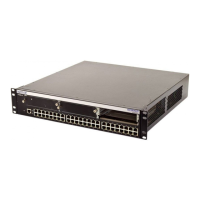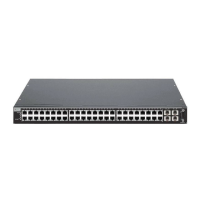Structure of This Guide
xxxvi About This Guide
Chapter 5, Setting User Accounts and Passwords, describes user account and password
management functionality.
Chapter 6, Management Authentication Notification MIB Commands, provides detailed
information for the management authentication notification MIB set of commands. Management
authentication notification MIB functionality includes enabling/disabling the sending of SNMP
notifications when a user login authentication event occurs for various authentication notification
types.
Chapter 7, Setting the Security Mode, describes how to configure the switch security mode.
Chapter 8, Configuring System Power and PoE, describes the commands used to review and set
system power and PoE parameters on devices that offer Power over Ethernet.
Chapter 9, Transmit Queue Monitoring Configuration, describes the commands used to monitor
transmit queues and, if a queue is found to be stalled, to take corrective action.
Chapter 10, Discovery Protocol Configuration provides how to configure discovery protocols
supported by the device.
Chapter 11, Port Configuration, describes how to review and configure console port settings, and
how to enable or disable switch ports and configure switch port settings, including port speed,
duplex mode, auto-negotiation, flow control, port mirroring, link aggegation and broadcast
suppression.
Chapter 12, SNMP Configuration, describes how to configure SNMP users and user groups,
access rights, target addresses, and notification parameters.
Chapter 13, Spanning Tree Configuration, describes how to review and set Spanning Tree bridge
parameters for the device, including bridge priority, hello time, maximum aging time and forward
delay; and how to review and set Spanning Tree port parameters, including port priority and path
costs. Configuring the SpanGuard and Loop Protect functions is also described.
Chapter 14, 802.1Q VLAN Configuration, describes how to create static VLANs, select the mode
of operation for each port, establish VLAN forwarding (egress) lists, route frames according to
VLAN ID, display the current ports and port types associated with a VLAN and protocol, create a
secure management VLAN, and configure ports on the device as GVRP-aware ports.
Chapter 15, Policy Classification Configuration, describes how to create, change or remove user
roles or profiles based on business-specific use of network services; how to permit or deny access
to specific services by creating and assigning classification rules which map user profiles to frame
filtering policies; how to classify frames to a VLAN or Class of Service (CoS); and how to assign or
unassign ports to policy profiles so that only ports activated for a profile will be allowed to
transmit frames accordingly.
Chapter 16, Port Priority Configuration, describes how to set the transmit priority of each port
and configure a rate limit for a given port and list of priorities.
Chapter 17, IGMP Configuration, describes how to configure Internet Group Management
Protocol (IGMP) settings for multicast filtering.
Chapter 18, Network Management, describes how to manage general switch settings, how to
monitor network events and status,and how to configure node aliases.
Chapter 19, Configuring System Logging, describes how to display and configure system
logging, including Syslog server settings, Syslog default settings, and the logging buffer. This
chapter also includes information about security audit logging.
Chapter 20, Configuring SNTP, describes how to use CLI commands to configure the Simple
Network Time Protocol (SNTP), which synchronizes device clocks in a network. Also included are
SNTP authentication commands.
Chapter 21, RMON Configuration, describes how to use RMON (Remote Network Monitoring),
which provides comprehensive network fault diagnosis, planning, and performance tuning

